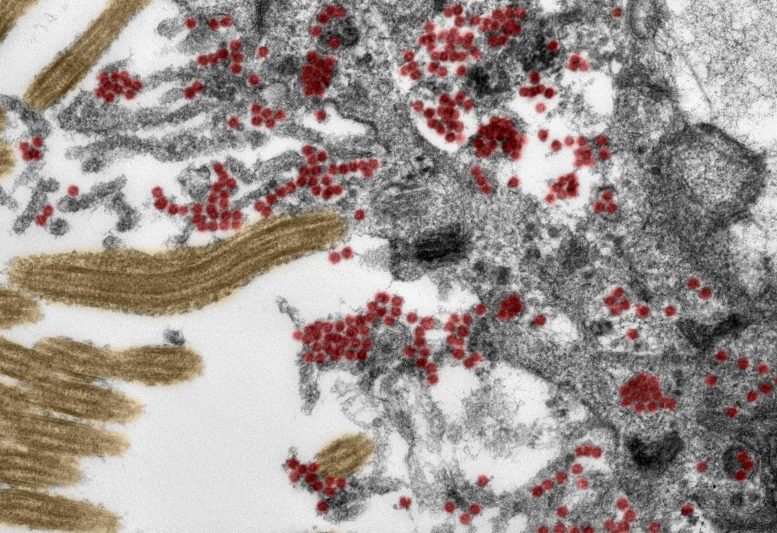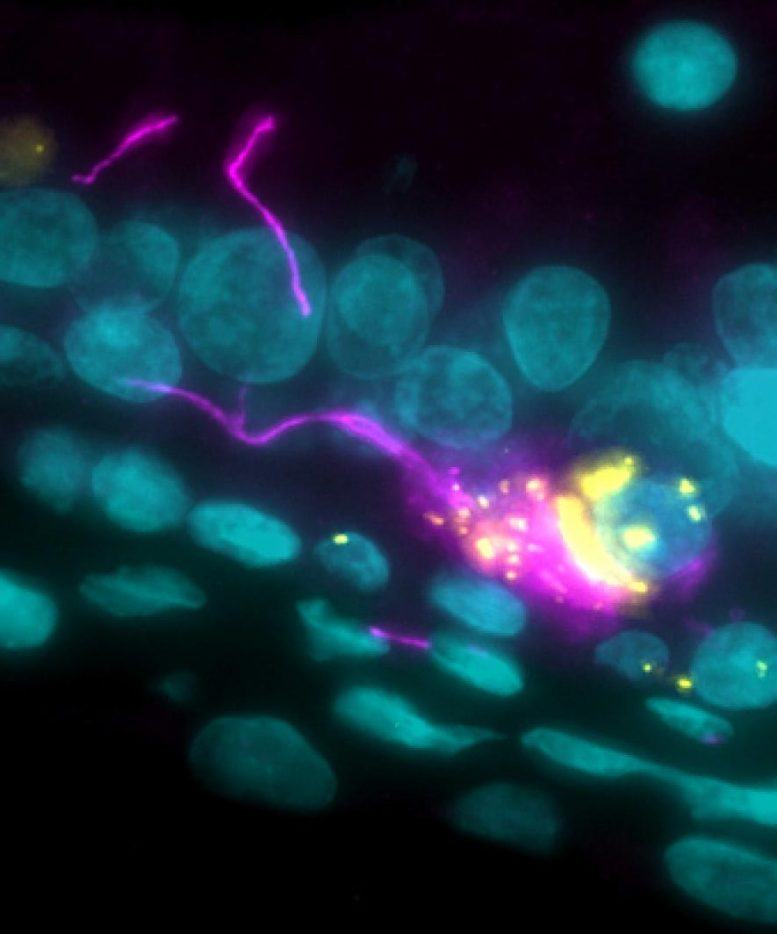
Using post-mortem tissue samples, a team of researchers from Charité – Universitätsmedizin Berlin have studied the mechanisms by which the novel coronavirus can reach the brains of patients with COVID-19, and how the immune system responds to the virus once it does. The results, which show that SARS-CoV-2 enters the brain via nerve cells in the olfactory mucosa, have been published in Nature Neuroscience. For the first time, researchers have been able to produce electron microscope images of intact coronavirus particles inside the olfactory mucosa.
It is now recognized that COVID-19 is not a purely respiratory disease. In addition to affecting the lungs, SARS-CoV-2 can impact the cardiovascular system, the gastrointestinal tract, and the central nervous system. More than one in three people with COVID-19 report neurological symptoms such as loss of, or change in, their sense of smell or taste, headaches, fatigue, dizziness, and nausea. In some patients, the disease can even result in stroke or other serious conditions. Until now, researchers had suspected that these manifestations must be caused by the virus entering and infecting specific cells in the brain. But how does SARS-CoV-2 get there? Under the joint leadership of Dr. Helena Radbruch of Charité’s Department of Neuropathology and the Department’s Director, Prof. Dr. Frank Heppner, a multidisciplinary team of researchers has now traced how the virus enters the central nervous system and subsequently invades the brain.

As part of this research, experts from the fields of neuropathology, pathology, forensic medicine, virology, and clinical care studied tissue samples from 33 patients (average age 72) who had died at either Charité or the University Medical Center Göttingen after contracting COVID-19. Using the latest technology, the researchers analyzed samples taken from the deceased patients’ olfactory mucosa and from four different brain regions. Both the tissue samples and distinct cells were tested for SARS-CoV-2 genetic material and a ‘spike protein’ which is found on the surface of the virus. The team provided evidence of the virus in different neuroanatomical structures which connect the eyes, mouth, and nose with the brain stem. The olfactory mucosa revealed the highest viral load. Using special tissue stains, the researchers were able to produce the first-ever electron microscopy images of intact coronavirus particles within the olfactory mucosa. These were found both inside nerve cells and in the processes extending from nearby supporting (epithelial) cells. All samples used in this type of image-based analysis must be of the highest possible quality. To guarantee this was the case, the researchers ensured that all clinical and pathological processes were closely aligned and supported by a sophisticated infrastructure.
“These data support the notion that SARS-CoV-2 is able to use the olfactory mucosa as a port of entry into the brain,” says Prof. Heppner. This is also supported by the close anatomical proximity of mucosal cells, blood vessels, and nerve cells in the area. “Once inside the olfactory mucosa, the virus appears to use neuroanatomical connections, such as the olfactory nerve, in order to reach the brain,” adds the neuropathologist. “It is important to emphasize, however, that the COVID-19 patients involved in this study had what would be defined as severe disease, belonging to that small group of patients in whom the disease proves fatal. It is not necessarily possible, therefore, to transfer the results of our study to cases with mild or moderate disease.”
The manner in which the virus moves on from the nerve cells remains to be fully elucidated. “Our data suggest that the virus moves from nerve cell to nerve cell in order to reach the brain,” explains Dr. Radbruch. She adds: “It is likely, however, that the virus is also transported via the blood vessels, as evidence of the virus was also found in the walls of blood vessels in the brain.” SARS-CoV-2 is far from the only virus capable of reaching the brain via certain routes. “Other examples include the herpes simplex virus and the rabies virus,” explains Dr. Radbruch.
The researchers also studied the manner in which the immune system responds to infection with SARS-CoV-2. In addition to finding evidence of activated immune cells in the brain and in the olfactory mucosa, they detected the immune signatures of these cells in the cerebral fluid. In some of the cases studied, the researchers also found tissue damage caused by stroke as a result of thromboembolism (i.e. the obstruction of a blood vessel by a blood clot). “In our eyes, the presence of SARS-CoV-2 in nerve cells of the olfactory mucosa provides a good explanation for the neurologic symptoms found in COVID-19 patients, such as a loss of the sense of smell or taste,” explains Prof. Heppner. “We also found SARS-CoV-2 in areas of the brain which control vital functions, such as breathing. It cannot be ruled out that, in patients with severe COVID-19, presence of the virus in these areas of the brain will have an exacerbating impact on respiratory function, adding to breathing problems due to SARS-CoV-2 infection of the lungs. Similar problems might arise in relation to cardiovascular function.”
Reference: “Olfactory transmucosal SARS-CoV-2 invasion as a port of central nervous system entry in individuals with COVID-19” by Jenny Meinhardt, Josefine Radke, Carsten Dittmayer, Jonas Franz, Carolina Thomas, Ronja Mothes, Michael Laue, Julia Schneider, Sebastian Brünink, Selina Greuel, Malte Lehmann, Olga Hassan, Tom Aschman, Elisa Schumann, Robert Lorenz Chua, Christian Conrad, Roland Eils, Werner Stenzel, Marc Windgassen, Larissa Rößler, Hans-Hilmar Goebel, Hans R. Gelderblom, Hubert Martin, Andreas Nitsche, Walter J. Schulz-Schaeffer, Samy Hakroush, Martin S. Winkler, Björn Tampe, Franziska Scheibe, Péter Körtvélyessy, Dirk Reinhold, Britta Siegmund, Anja A. Kühl, Sefer Elezkurtaj, David Horst, Lars Oesterhelweg, Michael Tsokos, Barbara Ingold-Heppner, Christine Stadelmann, Christian Drosten, Victor Max Corman, Helena Radbruch and Frank L. Heppner, 30 November 2020, Nature Neuroscience.
DOI: 10.1038/s41593-020-00758-5
Never miss a breakthrough: Join the SciTechDaily newsletter.
2 Comments
Well done J amd Team. Proves my hypothesis that women are the superior Gender. Version 2.0 is always superior to version 1.0 . My respect for the recent one-time democratic President from the Sate of Georgia has increased manifold. His confession that he has lusted after others members of the opposite sex and that too publicly is indeed admirable. However, he never acted on such impulses and his self-control is indeed admirable. By the way, such impulses arenatural in all species , but the difference betwee Humans and thers is the Freedom to choose granted by the almighty to Humans , who he created in his/her image.
Coming back to Medical Aspects of this paper.
Have suspected and thought that the Brain was involved and my initial hypothesis, was not accurate or complete that the blood was the carrier of the Virus and infected all the organs. The Neurological damage reports led me to the same conclusion inuitively that has now been confirmed by yur research.
I always knew that the Brain is the Controller and all the Organs of the Body are normally controlled by the Brain. I knew it must be involved from day one , as without the same being infected , the reports of neurological damage did not make sense.
Braching of the blodd brain barrier is not as simple and the Virus needs to be well armed to be able to breach the same/
However the mechanism and how it did that was eluding me, till this paper came along. We still appear to be looking for Chemical Solutions and it may play a part in the same by enabling the same as some compoenents mentioned do appear to have the ability to do that.
However, here is another theory for the Scientific Community to explore. Just like the Human and Mammalian Ecosystem has many different systems which need to function like a well oiled team , for the body to remain healthy, so also all these systems which constitute the Human and mammalian ecosystems, and allows the functioning of the same seamlessly and in a completely integrated manner, ( Respiratory, Blood Circulatory, Respiratory, Digestive, etc. ) there appears to be a Neuron Circulatory system linked to the Brain (Controlller) , which can be breached by unfriendly Viruses , Pathogens and Bacteria. Though this may not be easy to do , it appears to be happening. Implications for future pandemics is quite worrying.
Unless Root Causes of all such breaches , which determines how the Controller is impcted , and protection against the root causes of such breaches are put in place to minimise the same, these temporary band aid fixes will not give us a risk-reduced Systemic Solution.
Interesting. Some Thoughts For Consideratiion.
1. The number may 11 not 9 . Why do I say that? Two Planets may have Crashed and Created the Kupier Belt.
2. Some Planets may have escaped the Gravitaional Pull from one of the Star Solar Systems andv have Created a Orbit of their Own!
3. The Speed of the Orbits and the eccentricity of the same as well as the acceleration/deceleration of the same may have a Role to play in the understanding of the Universe and answer the Question, Why are we here!
Mathematics is the Queen of the Sciences. Gets very little Respect. Needs to Change.
Opinions expressed are Personal.